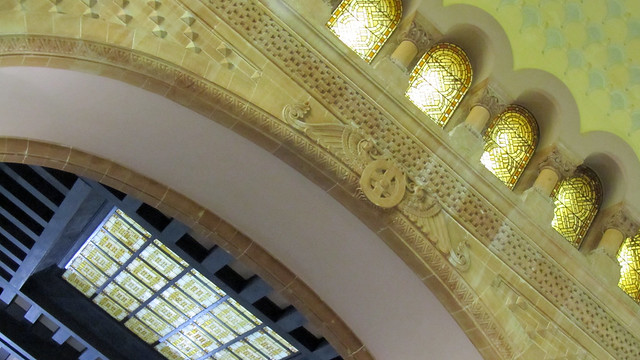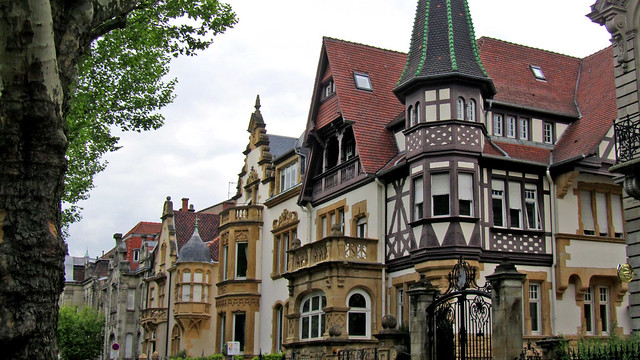May 29, 2013
Weekender: How do you pronounce Metz?
I called it “mets”, with an emphasis on the T, but Frédéric duly corrected me – it’s “mess”. Whaaaaat? But why?
*Gallic shrug*
“That’s just how it is.”


So I did a little digging. The name had its (Celtic) origin in Mediomatrici, which was then shortened into Mettis, before finally settled on Metz. The T was certainly part of the pronounciation in the past. This changed during the period of German occupation of Metz between 1871 and 1918. Annexed to the German Empire, the occupiers’ guttural speech seemed to make the T more pronounced than ever. The unhappy people rebelled in their own little way by dropping the sound of the T and voilà – you’ve got “mess”! Obviously, the pronounciation persists to this day.
Metz is not a mess, by the way, although you may be tricked into thinking maybe, just maybe, part of it is. We arrived on a Sunday afternoon to the sights of building materials on the side walks, barriers closing down roads and footpaths, and signs that works are being carried out in the city. Since it was Sunday, most shops were shuttered, few people were coming by around the train station and zero people were working on the sites, it evoked a strange feeling of abandoned city in the Wild West.




However, one just need to look around to know this is far from being the Wild West. For one, the train station itself is a magnificent building, perhaps the most beautiful station that I have seen so far. it is a solid neo-Romanesque building that outwardly resembles a church, but flanked with long palace wings. Carved pillars and arches, stained glasses and grand chandeliers are but part of the details. (Trying to photograph it without all the mess from the ongoing renovation works is another story though.)
Unfortunately, the station does not have a left luggage service and unwilling to drag a suitcase behind us all day, we tried our luck at a hotel across the station to see if they would store it for a small fees for us. Nope, but we were directed to a small tabac a couple of doors away, where the owner stored it for us for €5. Off we went then on our little city exploration.




As I mentioned when discussing about Nancy, I fell short on trip-planning for the weekend so it’s no surprise that we had little knowledge of what we will see here. During the wedding in Grosblie, Frédéric’s godfather told us that we must check out the Esplanade, so that was our only solid lead to start the afternoon. With the help of maps on our mobile phones, we started heading north, and at the same time took peeks into little streets along the way.
This was how we came to see Place Saint-Thiébault where an old city gate and its linked rampart were previously situated. A triumphal arch also sat here in the 1600 and was subsequently destroyed by the revolutionaries. Today, it is a beautiful square with fountains, surrounded by houses with classical façade.




Not far from here, we stumbled across the church of Saint Martin, one of the oldest churches in Metz. Built through various phases, the church is partly integrated to parts of the old city wall and from what we can see, lies in the same block to current day residential and commercial buildings. The interior of the church may not be very big, but the way the lights streamed in via the upper-level windows gave it a very spiritual significance.
Emerging from the church, we continued along the street to reach the Place de la République and the adjacent Esplanade. There’s some kind of magic mirror thing going on at the Place de la République, so I’m assuming if we had headed in there, we would be looking at ourselves through distorted glasses that can make me either as thin as reed or as plump as a peach. We were more interested in the Esplanade, or rather, Frédéric has spotted River Moselle a bit further on and he’d like a walk along the river front. It was a romantic little stroll, which perhaps could be improved if (1) the grey clouds hadn’t start to really hover above us, and (2) there weren’t more works that closed off parts of the river front leading towards the heart of the old town.




For someone walking around without a map (we had not used the maps on our phones since we took a quick look at the train station to orientate ourselves), we have certainly done very well with our sight-seeing strategy. Using River Moselle as our guide, we made our way towards the imposing Temple Neuf which, from afar, exudes “old castle” to me. However, as we drew closer to the church, I was reminded of Île de la Cité in Paris instead. The Temple Neuf is situated at the south-western tip of Île du Petit-Saulcy that forms the Imperial German Quarter, and when one focuses on purely the church and the flanking bodies of water lined with orderly buildings, there’s unmistakeable similarity between this and the scenery surrounding Notre Dame de Paris.
We were on our way to Quartier Saint-Vincent and about to explore more around the islands within central Metz when the sky opened up and started to pour. With not a single shop opened in the vicinity, we hurried back towards the south bank and took refuge in the only place nearby that I noticed earlier to be open – Comédie Café. It is more like a bar than café, with a touch of hard rock. I pondered about taking a photo but the barman looked a bit stern so I chickened out…




Now that we’re back in the vicinity of Saint-Étienne de Metz, aka the Metz Cathedral, we decided to pay it a visit instead of going back to the islands. The access to Gothic cathedral is through a portal on its south-western corner (the norm is for main portal to be found on the west façade) called Portal of the Virgin, under the watchful eyes of saints, gargoyles and other fantastic beasts. Unfortunately I don’t know enough of the bible to identify the main figures of the portal but one pair which caught my attention – Ecclesia and Synagoga – mostly because I recognise the blindfolded iconography of Synagoga from a visit to another cathedral.
This Gothic cathedral has one of the highest naves in the world and the amount of stained glass windows on display was simply impressive. A number of distinct style is on showcase, from the works of the old masters such as Hermman von Münster and Valentin Bousch, to the more contemporary Roger Bissière, Marc Chagall and Jacques Villon. Within the cathedral, visitors can follow a carefully laid-out route for self-guided tour, where at each point of interest, a trilingual (French, German, English) panel dishes out further information about a particular feature or structure of the cathedral. Anyone interested in getting to know more about the legend of the town’s dragon, Graoully, would do well to head to the crypt for further information (we skipped this).




After our visit to the cathedral, we walked the streets in the neighbourhood, never quite knowing where we were going. We found the tourist visitor centre between the cathedral and the Hôtel de Ville but it was closed, so no luck in garnering some additional leads (nor free city map) to guide us through the city. However, our random exploration strategy so far had worked pretty well, so we continued our merry way guided by instinct.
During this time, we spotted, among others, an effigy of Graoully on rue Taison, place St Jacques, rue Serpenoise (but sadly not the Porte Serpenoise which we somehow missed, despite having walk most of the streets around it!), École Supérieure d’Art de Lorraine (ÉSAL), Chapelle des Templiers (Templar’s Chapel), Palais du Gouverneur (Governor’s Mansion) and l’Arsenal de Metz.




Our walk back towards the train station was via Avenue Foch, also part of the Imperial Quarter of Metz that includes the Governor’s Mansion and the Metz train station. The buildings on this street are august, many of the private villas resembling small palaces and castles rather than your typical residences. Built back in early 1900, the architecture style range from neo-Classic to neo-Baroque, and certainly they were meant to display the immense wealth and power of the German Empire during the post-Franco-Prussian war annexation.
Like Nancy, I think that Metz is perfect for a weekend getaway rather than as a day-trip from Paris. A 2-day trip would have afforded me more time to visit some museums (notably missed sight of this trip – Metz-Pompidou which somehow completely slipped our mind and we didn’t even try to seek out, and was situated just behind the train station!) and take in other monuments that we did not have time to go to due to time constraint.




Yup, a return trip to the region is definitely warranted. Perhaps next time we should consider a roadtrip in the region. I would hapily revisit Nancy, Metz and Strasbourg (which I visited a couple of years ago) and I’d like to see Mulhouse, Colmar Verdun, not to mention riding the Route des Crêtes (Route of the Ridges) and the Alsace wine route. So. Much. Possibilities!
Metz: full photoset on Flickr













Great post! There are so many cities which make great weekend gateways, only less crowed and less expensive than Paris…
xx Alice from Le Grumeau
Thanks Alice – you are right, there are many fabulous weekend getaways just a couple of hours away from Paris. I’d love to explore more of them for sure!
Yeay…my weekly virtual holiday hehehe ;) Beautiful mess
and looks like the weather changes eh
nice when u can walk around free n easy to really get to know the place
Hehehe… the French Tourism should hire me ;)
It is nice to walk about and discover the city without preconceived notions, but at the same time, it also means I can easily miss out on something without knowing it (e.g. one of the figures of the cathedral portal shows St Clement holding a chain with dragon on his feet, but I didn’t notice it) until I get home. How does one balance that?
hehehe….maybe they should….go try ;)
well…there is always next time then….else no excuse to return to the same place eh
let me learn how to sell myself first, ok? ;)
with the high number of places to visit, to try to fit a trip back is going to be a bit tricky, but hey, one never knows. as long as i live here, it’s never too far away.
How much I enjoyed your wonderful article and photographs of Metz. I was stationed near there (Chambly Air Base) 1965-1966. I loved Metz . . . and the Gare! Many weekend nights waiting for the train and savoring the classic Onion Soup Gratinee and a vin blanc.
Your incredibly well detailed descriptions and photographs have rekindled memories of a very special time of my life including so many wonderful French citizens. Merci encore!